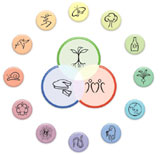Written By David Holmgren
Permaculture is an approach to designing human settlements and perennial agricultural systems that mimic the relationships found in natural ecologies. It was first developed practically by Austrian farmer Sepp Holzer on his own farm in the early 1960s and then theoretically developed by Australians Bill Mollison and David Holmgren and their associates during the 1970s in a series of publications. — wikipedia.org
Central to permaculture are the three ethics: care for the earth, care for people, and fair share. They form the foundation for permaculture design and are also found in most traditional societies. Here are the 12 principles of permaculture as described by David Holmgren.
- Observe and Interact – “Beauty is in the mind of the beholder”
By taking the time to engage with nature we can design solutions that suit our particular situation. - Catch and Store Energy – “Make hay while the sun shines”
By developing systems that collect resources when they are abundant, we can use them in times of need. - Obtain a yield – “You can’t work on an empty stomach”
Ensure that you are getting truly useful rewards as part of the working you are doing. - Apply Self Regulation and Accept Feedback – “The sins of the fathers are visited on the children of the seventh generation”
We need to discourage inappropriate activity to ensure that systems can continue to function well. Negative feedback is often slow to emerge. - Use and Value Renewable Resources and Services – “Let nature take its course”
Make the best use of nature’s abundance to reduce our consumptive behavior and dependence on non-renewable resources. - Produce No Waste – “Waste not, want not” or “A stitch in time saves nine”
By valuing and making use of all the resources that are available to us, nothing goes to waste. - Design From Patterns to Details – “Can’t see the forest for the trees”
By stepping back, we can observe patterns in nature and society. These can form the backbone of our designs, with the details filled in as we go. - Integrate Rather Than Segregate – “Many hands make light work”
By putting the right things in the right place, relationships develop between those things and they work together to support each other. - Use Small and Slow Solutions – “Slow and steady wins the race” or “The bigger they are, the harder they fall”
Small and slow systems are easier to maintain than big ones, making better use of local resources and produce more sustainable outcomes. - Use and Value Diversity – “Don’t put all your eggs in one basket”
Diversity reduces vulnerability to a variety of threats and takes advantage of the unique nature of the environment in which it resides. - Use Edges and Value the Marginal – “Don’t think you are on the right track just because it’s a well-beaten path”
The interface between things is where the most interesting events take place. These are often the most valuable, diverse and productive elements in the system. - Creatively Use and Respond to Change – “Vision is not seeing things as they are but as they will be”
We can have a positive impact on inevitable change by carefully observing and then intervening at the right time.

